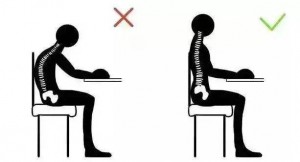What Is Scoliosis?
Scoliosis is a common skeletal problem. In standing posture, the normal spine arrangement should be symmetrical on both sides of the body, whether it’s frontal or dorsal view. And the normal spine arrangement should be straight from top to bottom.
If you see the spine bending and skewing toward any side of the body in a standing position, it could be scoliosis. Generally, it causes asymmetric spaces between the arms and the torso, and the right shoulder is higher. However, scoliosis does not only mean a single bending or skewing in a single plane, it usually comes with spine rotation. What’s worse, it could also affect the movement of the scapula, resulting in limited shoulder joint range of motion.
What Are the Hazards of Scoliosis?
1. Affect spine shape and function
Scoliosis causes abnormalities such as deformity of the spine, uneven shoulders, thoracic deformities, pelvic tilt, unequal legs, poor posture, limited joint ROM, etc.
2. Affect physiological health
Spinal deformity easily leads to intractable pain in shoulder, back and waist. In some severe cases, it can even cause nerve damage, nerve compression, limb sensory impairment, lower limb numbness, abnormal urination and defecation and some other symptoms.
3. Impact on cardiopulmonary function
The number of alveoli in patients with early-onset scoliosis is lower than in normal people, and the diameter of the pulmonary artery is also much lower than that of people of the same age. The chest volume of patients with scoliosis decreases. It affects gas exchange, and easily causes breathlessness and affects blood circulation.
4. Affect the gastrointestinal system
Scoliosis reduces the volume of abdominal cavity and disturbs the regulation function of spinal nerve on viscera, which in turn causes gastrointestinal system reactions such as loss of appetite and indigestion.
In simple, scoliosis affects the quality of life, and severe scoliosis can lead to paralysis or even be life-threatening.
What Causes Scoliosis?
The causes of scoliosis are still unknown, and most (more than 80%) of them are idiopathic. In addition, there are also congenital scoliosis and neuromuscular scoliosis (e.g., cerebral palsy).
Modern people bow for a long time (poor posture) to play their tablets and mobile phones is an important cause of scoliosis.
Poor posture can cause imbalance of muscles and fascia on both sides of the spine, thus resulting in fatigue and stiffness. Over time, poor posture will cause chronic myofascial inflammation, and the spine will be more likely to degenerate, causing the consequences of scoliosis.
How should Scoliosis be Corrected?
Rehabilitation can be divided into three parts, namely, changing the way of breathing, improving poor posture, and improving muscle balance.
1. Change breathing pattern
Scoliosis and thoracic deformation which could cause compression on heart and lungs, causing respiratory disorders. Therefore, pursed lips breathing is needed to correct symptoms such as low inspiratory volume on the concave side.
2. Improve poor posture
Poor posture and scoliosis can be mutually causal and in a vicious circle. Therefore, it is important to correct poor posture to control the development of scoliosis. What’s more, raise head and keep chest straight, do not bend hunchback, and try to avoid sitting cross-legged for a long time.

One small suggestion: try to replace the office chair with a fitness ball, because once the sitting position is seriously deformed, there is no way for people to sit on the fitness ball.
3. Improve muscle imbalance
Patients with scoliosis have unbalanced muscle strength on both sides. Foamrollers, fitness ball or Pilates can be used to relax the tense muscles and conduct symmetrical training so as to improve function, relieve symptoms and control the development of the disease.
Also, don’t be a bower!
Post time: Jul-20-2020






